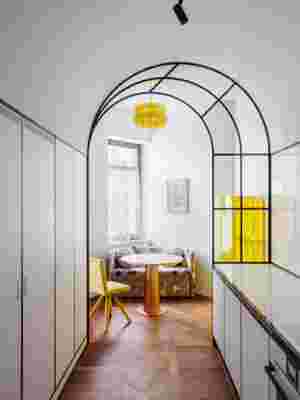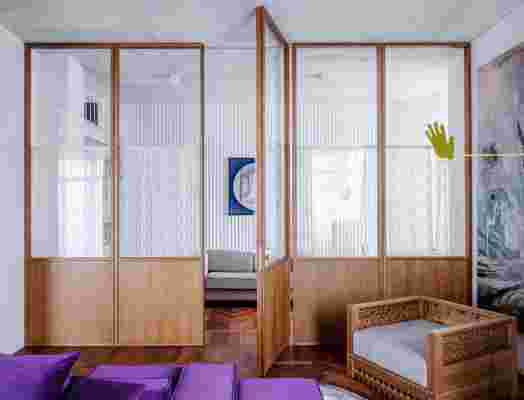When a mutual friend introduced Russian fashion designer Ksenia Chilingarova to Moscow- and New York–based architect Harry Nuriev of Crosby Studios, Chilingarova says, “I guess it was love at first sight.” He listened, he understood color, and, most importantly, he complimented her outfit: “That day I was wearing oversized Raf Simons shirt,” remembers the designer behind cult outerwear brand Arctic Explorer. So when they sat down to talk about her new home in Moscow—a blank-slate apartment in a quiet neighborhood on the edge of the city—she gave Nuriev carte blanche. “I knew we liked the same things,” Chilingarova explains. “So I just let him do his job.”
Aesthetically, they spoke the same language (a penchant for purple; a love of Vetements), but it was their shared Soviet upbringing that they really bonded over. “We grew up surrounded by boundaries,” says Chilingarova. “I remember very well how my ideas on Russian literature were criticized by schoolteachers only because they were different from the official ones. Harry had the same problems. They way he sees the world; the way I dress—it’s not exactly Russian style. But maybe being different brought us together.”

“Gabrielle Chanel would definitely make her breakfast here,” quips Nuriev of the sleek black and white kitchen, with a kick of yellow, that he designed for Chilingarova.
Nuriev zeroed in on this idea, honing a kind of retrofuturist Russian aesthetic that aligned with both of their personal styles: “For me, Soviet design is all about elegant office life with wooden wall paneling and lots of cabinets,” Nuriev explains. “A little Mad Men , but not too bougie.” Chilingarova set a few rules: She needed a big wardrobe, room for her art collection, and, above all else, a sense of comfort—for herself and the steady flow of creative visitors that could drop in at any moment.
“I needed a place to live, not a museum,” she says. “A place I could have small parties for young Russian artists, stylists, and journalists. Almost every two weeks a young stylist or photographer wants to do a fashion or art shoot in my apartment.” Understandably so. The space Nuriev conjured is a photographer’s dream. Inspired by the fashions and furnishings in Office Romance , a film both client and designer remembered from childhood, Nuriev created rooms with windowed, wood-paneled walls, bringing warmth and light into the space that originally lacked both. He then laid the floors with herringbone parquet, similar to those from his grade school, and curtained windows with lace, a vintage touch he remembers from his grandmother’s house.

Windowed, wood-paneled walls covered in vintage-inspired lace curtains maximize the light in the space.
“She used lots of laces and carved wood furniture to make the space more warm—more honest,” says Nuriev. He reinvented both ideas for his thoroughly modern client. An armchair, dining chairs, and gigantic dining table were carved from oak. And with the addition of colorful graffiti (a nod to Chilingarova’s love of Basquiat) and velvet cushions, they feel anything but granny-ish.
The ultimate resource for design industry professionals, brought to you by the editors of Architectural Digest

Nuriev’s own product collaborations punctuate the space. The powder-coated shelving and hand lamps he designed with Opening Ceremony stand like totems in the living room. And the latticework lamps—inspired by the elaborate one-of-a-kind tin downpipes and chimneys used on wooden houses in rural Russia—debuted at Design Miami in 2017 have been reenvisioned as lacy pendants throughout the home. Around them, the walls are appointed with oil paintings by young Russian artists, including Sofia Stupenkova, Nikolay Koshelev, Sasha Pasternak, and Dmitriy Mironov.
Chilingarova hopes her apartment can serve as a platform for them. “I believe in the potential of young Russian artists," she explains. "So I wear Russian designers and buy Russian art. It’s sort of a mission and I enjoy it very much.”
